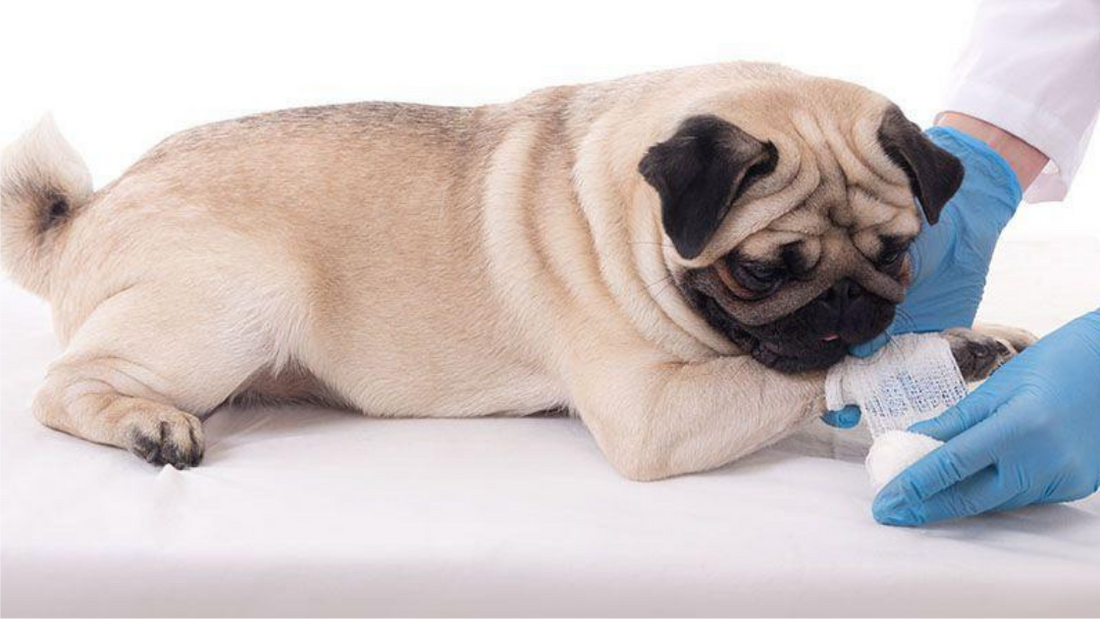
How to Bandage a Dog Injury Safely
Share
We all know that having a dog is a big responsibility.
It can be difficult to keep a close eye on your furry friend at all times, especially if they are particularly active.
Sometimes, despite your best efforts, your dog might get injured either at home or out on a walk. You can’t always stop this happening, but you can make sure that you are fully prepared if and when the time comes.
Bandaging your dog is an important part of helping them to recover from a wide range of injuries. Not only does dressing your dog’s wounds help to prevent infection, but it will also help reduce the likelihood of any permanent damage being caused.

Step-by-step instructions on how to dress a dog injury
It’s best to get your dog checked out by a professional if they get injured. However, it’s best to also know what to do if you end up having to cover a dog wound yourself.
Bandaging your dog quickly is one of the best ways to help them steer clear of infections or further injury to an already sensitive and weakened area. How to bandage an open wound on a dog can seem tricky, but it is straightforward if you follow these three simple steps.
-
Always begin by thoroughly cleaning and disinfecting the wound. Dogs can often sustain injuries in less than hygienic places, so it’s really important to make sure the injured area is cleaned in order to prevent infection.
-
Next, bandage your dog using an absorbent pad and a gauze bandage. The absorbent pad will help to soak up any fluids and cushion the area to prevent it from further knocks and scrapes. When wrapping the bandage around your dog, make sure you fully cover the injured area and also cover an inch or two of skin or fur on each side of the wound.
-
If necessary, use adhesive tape. Depending on the location of the injury, you may need to use some gentle adhesive pet bandage tape to secure the bandage and stop it from slipping or coming loose.
Looking after a dog in bandages
Once you’ve bandaged your dog’s wound, it needs regular checks and maintenance to make sure it is healing properly.
Here are our expert tips on how to care for your injured dog:
-
Make sure your pet’s bandage is clean and dry.
When your pet has a bandage, it should always be clean and dry. As far as possible, it’s important to make sure your pet stays inside most of the time when it has a bandage.
To prevent the bandage from getting wet when the pet goes to pee or poop, a trash bag or plastic covering should cover the bandaged leg. You could even use empty bread bags.
When your pet wets or dirties the bandage, it will need changing. Make sure to check the bandage twice a day to see if it is clean and dry.
Check also for foul odors or discharge and if there is any, call your veterinarian immediately.
-
Check that the bandage remains in place.
Look closely at the position and the location of the bandage when you do check. Look at your dog’s toes if the injury is on the paw or lower leg, as the bandage might have slipped upwards, making the toes stick out.
After bringing home your pet from the veterinarian, make sure that the bandage is still in place. Your pet might have been irritated by it and tried to scratch or chew it off.
You’ll also want to watch out for the dressing becoming loose, particularly if your dog’s injury is on the abdomen or leg area.
This is because one end will be bigger than the other and eventually become narrower. When the bandage telescopes down the limb of the dog it may bunch up and abrade the limb. If that happens, the bandage will need to be changed.
- Check for signs of poor circulation or infection.
If your dog has a leg dressing, you’ll need to make sure it isn’t too tight. At least twice a day, take a look at your dog’s toes to make sure they appear normal. In particular, keep an eye out for any signs of sweating, swelling, pain, skin chafing, redness, discharge or swelling both before and after the wound has been dressed. - To prevent the pet from chewing the bandage because of the bothersome experience it gives, put an Elizabethan collar. If you have observed that the pet is chewing or scratching it excessively, ask the vet if there might be problems.
When to take your dog to the vet following an injury
It can sometimes be hard to know whether any changes in your dog’s behaviour or appearance following an injury warrant a return to the vet. Whilst it’s always better to be safe than sorry, there are some situations in which it is essential that your dog is seen by a professional as quickly as possible.
Always consult a professional if your pet shows any sign of:
- Swelling above or below the bandage
- Bleeding above, below or through the bandage
- A bad smell coming from the wound
- Any fluids seeping from the wound

How to wrap a dog wound in tricky areas of the body
Dressing a dog wound can be more challenging in certain parts of the body. Here are our essential tips on bandaging a dog injury in various areas without difficulty.
How to bandage a dog's paw
When dressing your dog’s paw, you first want to make sure that it is completely clean. Because of their location, paw wounds are particularly vulnerable to having debris lodged inside.
You can use sterilised tweezers to carefully remove any obvious debris before cleaning and bandaging your dog’s paw.
If there is any deeply lodged debris, you’ll need to have this removed by a vet. Trying to remove it yourself might only push it further into the flesh.
For more on how to dress a dog’s foot, see these five essential first aid tips.
How to bandage a dog’s ear
Anyone whose pet has experienced an injury in this area before knows how difficult it can be to dress and keep clean. Bandages typically do not stay in place very long in this area.
Although ear injuries can occur during rough play or by scraping against a rough surface during a walk, they can also commonly be a sign of ear infections. This is because dogs often shake their heads roughly when experiencing discomfort caused by an ear infection, and this can lead to a tear in the skin of the ear.
If the wound is quite small, you might have success with applying a liquid bandage. Otherwise, there’s little you can do other than be patient. Keep trying, and don’t be afraid to wrap the dressing all the way around your pet’s head in order to keep it in place.
You can find out more about caring for a dog’s ear injury here.
How to bandage a dog's tail
It’s a cruel irony of a dog’s life that he or she might actually sustain a tail injury simply by being too happy - in other words, by wagging his or her tail too vigorously.
The key to keeping a dog tail wound dressing in place is to use plenty of adhesive bandage tape. You can wrap it around the bandage and a little on either end of the dressing.
You might find a spiral shape works best, or you can cut your tape into strips and apply several in loops around the width of the tail, and one long strip down the length of the tail to hold everything in place.
For full instructions on how to bandage an injury on your dog’s tail, take a look at this detailed tutorial.
How to bandage a dog's shoulder
The easiest way to apply a wound dressing to a dog’s shoulder or side is to use an elasticated bandage. This will allow your pet to have enough freedom of movement to get about day to day, whilst still providing protection for the injured area.
Make sure not to tie the bandage too tightly as this will restrict your pet’s movement and may even impede blood circulation.
You can see full instructions for bandaging a dog shoulder or side injury here.
We hope this guide to bandaging your dog has been useful! Remember, always consult a professional and, if in doubt, the best thing you can do is take your pet to be checked over by a veterinarian.
To find out how to keep your dog safe from harm at home, check out this list of household dangers for dogs.

